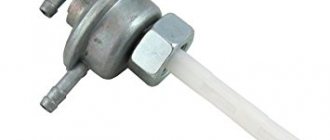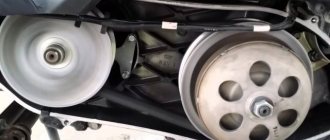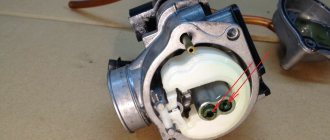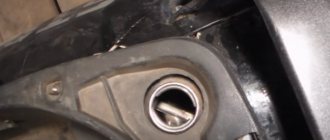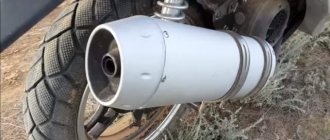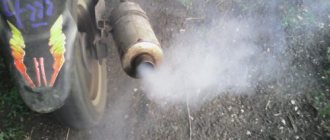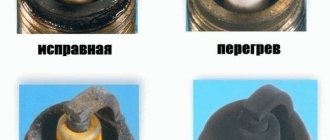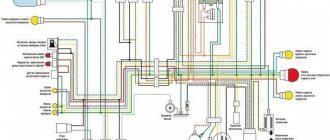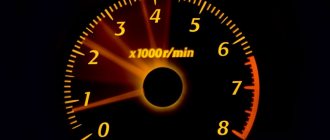When the scooter starts to stall while driving, it needs to be corrected as soon as possible. As a rule, this is not a serious breakdown and can be fixed without replacing spare parts. These problems are usually related to the spark plug and carburetor. So, why does the scooter stall while driving?!
This problem may be related to several parts. The reasons may be : spark plug, lack of gasoline and lack of air. We will look at why the scooter stalls while driving and then starts working again.
Cleaning and adjusting the carburetor
If you don't know why the scooter stalls when you give it gas, first check and adjust the carburetor.
If it was often removed and adjusted, it may be that somewhere it began to leak air. If such a problem occurs, you can use a sealant or buy gaskets for the carburetor. Let’s say the scooter stalls, you don’t know what to do. Then the first thing we do is clean the carburetor. Mostly the jets and auxiliary systems become clogged with dirt, so after cleaning the carburetor and adjusting all the jets, you can try to start the scooter again and give it gas. If the problem is not solved, move on to the main action - adjusting the needle to adjust the quality of the mixture. The needle in the carburetor performs the main task - adjusting the amount of fuel that is then supplied to the combustion chamber. Basically, you can adjust the quality of the mixture using a special jet on the carburetor, but if working with it does not produce results, you will have to manipulate the needle.
The needle is in close contact with the throttle handle, so when the handle is opened, the needle rises up and allows fuel to be supplied. That is, the higher the needle is raised, the more gasoline flows in and the power increases. Power guarantees better speed and traction. If you disassembled the carburetor, taking out the needle you will see 5 grooves on it, one of which has a retaining ring installed. Typically, such a ring is located in the center, that is, on the 3rd groove. If you lift the locking ring up, the needle will drop lower. This allows a leaner mixture to be supplied to the evaporation system, in which more air is supplied than gasoline. When installing the ring on the 4th and 5th grooves, the mixture becomes richer, where more gasoline is supplied than air.
Be careful that if you put the ring up or down as much as possible, this will not give the best result; the adjustment must be done gradually. Otherwise, the scooter will overheat, there will be a loss of power, and our main problem is that the scooter will stall when you press the gas handle. To find out the quality of the mixture, check the spark plug; its color will indicate whether the mixture is rich or lean.
Please note that there may also be other reasons why the scooter stalls when applying gas. Above we indicated the main ones; for some, the scooter stalls due to improper operation of the generator. Try, adjust, and share your problems and how to solve them.
Video
Main reasons
So, let’s look at why the 4t scooter won’t start – the reasons can be roughly divided into the following categories:
- fuel system malfunctions
- ignition system malfunctions
- piston group malfunctions
- malfunction of the gas distribution mechanism (GRM).
Each of these 4 categories has its own several possible causes. When diagnosing a scooter, you should carefully pay attention to each category and the problem in it. Step by step, eliminating faults, you will definitely find the cause. And then it’s a matter of technology!
Advice! Remember that there may be several reasons. Therefore, having eliminated one breakdown, you should still check the serviceability of other devices from the list of possible faults.
Fuel system malfunctions
If there is no gasoline in the tank, the scooter will not start - everyone knows. The same situation occurs when the fuel system malfunctions - gasoline does not reach the combustion chamber. The consequence is that there is nothing to burn, so the engine does not start. The reasons may be as follows:
- faulty fuel valve
- clogged fuel filter
- contaminated carburetor, failure of its individual parts
- The vacuum suction supplied to the fuel tap does not work.
Tap
It is recommended to start repairs with the simplest ones. In this case, the diagnosis begins with the fuel tap (if there is gasoline in the tank). To check operation, remove the fuel supply hose from the carburetor, then crank the engine with the starter or crank. The serviceability of the tap will be visible by the stream of gasoline flowing from the hose.
The first thing you need to do is make sure there is gasoline in the fuel tank by opening the gas tank cap and looking inside
To make sure that the fuel tap of the scooter is working properly, you should disconnect the gasoline supply hose from the carburetor and, after cranking the engine, make sure that gasoline is flowing from the hose in a stream (observe fire safety measures!)
A constant flow of fuel, even when the engine is stopped, or a lack of fuel supply through the hose indicates a breakdown of the fuel valve. If fuel is constantly leaking, change the valve immediately. Otherwise, you should pay attention to the condition of the fuel hoses, and only then replace the fuel tap.
Filter
The serviceability of the filter is diagnosed visually and by blowing. A dirty filter should be replaced immediately. If the filter looks clean, but does not blow in the desired direction, it means it is clogged and requires replacement.
Carburetor
A dirty carburetor is another reason why fuel does not reach the combustion chamber. The device becomes dirty due to poor filters (fuel and air) and poor fuel quality. Here is a list of actions necessary to eliminate carburetor malfunction:
- remove the carburetor and disassemble it
- rinse and blow out the holes with compressed air (if compressed air is not available, use a regular pump)
- pay attention to the condition of the float chamber, both the float itself and its adjustment; condition of the locking needle - is it worn out or sunk?
- Clean the fuel nozzle thoroughly.
Remember! There are no small details in carburetor repair! One missed moment may cost you to clean the entire carburetor again and find out the cause.
Ignition system malfunctions
Another possible reason why the engine does not work is a malfunction of the ignition system. This group includes many different little things, each of which can become the main reason for the engine not starting.
- dirty or faulty spark plug
- high voltage wire
- ignition coil
- faulty ignition sensor
- failed switch.
Spark plug
Let's start our search again with the simplest thing. Unscrew the spark plug from the cylinder, put a cap on it and lean the electrodes against the cylinder. Next, rotate the engine with the starter. In this case, a spark should jump between the two electrodes of the spark plug - straight and curved. If it is missing, you should perform a number of actions:
- Clean the spark plug from carbon deposits and oil contaminants using a rag and a metal brush
- warm the candle on the fire of a gas burner
- set the optimal gap between the electrodes - the gap should be about 1-1.5 mm.
After completing these steps, check for spark again. If it appears, then you can try to start the engine. If there is no spark, replace the spark plug with a new one. If there is no spark on the new spark plug, you should pay attention to deeper problems.
To check the spark in the spark plug, lean it against the metal frame (engine) and turn the engine
High voltage wire
The most common problem with a wire is its exposure in a certain place (broken wire). A working wire should spark off the cylinder body or other metal part of the engine when the tip is removed.
If it’s not scary, you can check for voltage with your finger, but it’s better to rest it against the engine. A broken wire will conduct electricity at the break point without reaching the spark plug. The exposed area should be insulated or the wire replaced with a new one.
You can check the high-voltage wire using a special indicator screwdriver
Ignition coil
To test the ignition coil, you need a device for measuring electrical quantities - a multimeter. Disconnect the coil from the scooter: remove the tip of the wire from the spark plug, unscrew the bolt securing the coil and disconnect its contacts.
Using a multimeter, measure the resistance at the coil contacts. Also measure the resistance between the contacts and the spark plug output. The optimal values for the coils of different scooters can be found by the model of the scooter. For example, the optimal resistance of the primary winding of the ignition coil on a Honda Dio scooter is 0.2-0.3 Ohm; secondary winding - 8.2-9.3 kOhm.
Checking with a multimeter
Piston group malfunctions
Having an insufficient degree of air compression in the engine cylinder, the scooter starts poorly or does not start at all. Experienced scooter riders can immediately determine the approximate compression level. A conclusion about the value of compression can be made by trying to start the moped with a kick starter.
When more effort is required in a certain position, it means compression is present. If the leg does not provide resistance, then the necessary pressure is not created in the cylinder. To be more sure, you should use a compression gauge.
Unscrew the spark plug from the cylinder and insert the tip of the device there. Rotate the engine with the starter. The compression meter will show the exact value of the compression ratio. The optimal compression value is 10 kg/cm2. If the compression in the engine is less than 7 kg/cm2, the piston should be repaired or replaced.
Checking with a compression gauge
Timing faults
You don’t need to read this paragraph if you have a 2-stroke scooter, because such engines do not have a timing belt. The cause of a timing belt malfunction may be carbon deposits on the valves or improper adjustment.
This is what the gas distribution mechanism (GRM) of a scooter looks like
You can check the air leak by placing your hand against the air filter hole on the carburetor. You should feel the creation of a vacuum with your hand. You can attach a plastic bag to the hole and rotate the engine - the bag should be pulled inside the carburetor and tear.
Check using a plastic bag placed over the neck
If this does not happen, it is recommended to get to the timing mechanism and repair it. If necessary, cleaning should be done.
Honda dio 18 stopped starting
Forum rules MUST indicate the model, unit and symptoms of the malfunction in the topic title.
Heading form: - unit malfunction Example: electric starter does not work.
If the topic concerns general repair issues, the model may not be specified.
The main rule is that the title of the topic should be brief, but as fully as possible reflect its content. Topics whose title does not indicate at least the approximate essence of the question, such as “AAA. Save!”, “I have a problem, tell me,” will be DELETED.
Honda dio 18 stopped starting
Lingon » 08 May 2005 02:29
This means that lately the cold climate has been getting worse and worse. then it stopped even starting warm from the starter, sometimes it helped to kick it and then start it from the starter. the speed and acceleration seemed to be normal, then I was able to start it with difficulty with a kick from the 23rd time, and at that time it stalled at idle if I didn’t give it more gas. I decided to clean the carb, cleaned it, everything else didn’t help, I cleaned it now after completely disassembling it, washed everything completely and cleaned the jets and all the channels. I put everything together correctly, it won’t start - even though it cracked either from the kick or from the starter, I checked the spark - there is, and I also unscrewed the spark plug before after I cleaned the carb for the first time - it was covered in soot - I cleaned it and put it back - nothing has changed.
fuel is flowing, the fuel filter seems to be normal, but I have disconnected it from the line for now - still nothing helps, it won’t start and that’s it.
Tell me what to do next, unfortunately we don’t have any good craftsmen here. so we have to rely only on you.
The scooter starts and immediately dies
Moderator: Alex174
Dongest » June 14, 2012, 00:18
Andrey8640 » June 15, 2012, 01:59
NordMoto » June 15, 2012, 08:17 pm
There can be a lot of reasons. Spark plug, carburetor, vacuum fuel valve, CPG, valves, etc.
You unscrew the spark plug and see it’s black, wet and covered in soot. We replace it with a new one. If you have a compression gauge, we plug it in and turn it with the starter, see if the CPG is alive or if the valves are holding. The problem is not resolved, let's move on. Carb problem. We check the integrity of the membrane and blow it out. (don’t forget that the CVK carb and all pipes must be intact). We check the electrovalve enricher.
Dinosaur » Jun 16, 2012 7:51 pm
Because a Jap is worth fixing and driving. And it’s easier to throw away a Chinese car with the first breakdown. Here is a quote from the owner of a Honda Lead 50. And the 90s have even more resources.
NordMoto » June 17, 2012, 00:38
Dinosaur » June 17, 2012, 01:08
I had a couple of Chinese. Now, if you'll excuse my French, I won't sit next to them to poop.
Honda had a tact - replaced the rings once and drove for five years without going anywhere beyond the filter. Lida is generally unkillable. The entire repair in three seasons was replacing the battery.
Preliminary inspection of a motorcycle Minsk
Everyone understands that for stable operation of a motorcycle engine it is necessary that the required amount of fuel enters the cylinder. It is also required that there is a good spark at the spark plug contacts.
If the Minsk motorcycle does not start, this means that fuel is not entering the combustion chamber or there is no spark. You should not rush to unscrew the spark plug or remove the carburetor, but rather listen to the opinion of experts who recommend starting to eliminate this problem with a simple inspection.
When inspecting a Minsk motorcycle, you need to check the following:
- the presence of gasoline leaks on the hoses and the engine, after making sure that the gas tank tap is open;
- presence of parts of damaged motorcycle electrical wiring.
If an inspection of the motorcycle does not reveal possible causes of the malfunction, then you need to move on to the next step.
No spark
To check the spark, apply ground to the spark plug.
- - faulty spark plug,
- — breakage of the spark plug or armored wire, short circuit in the ignition coil,
- - there is no contact or the diode in the ignition switch with three wires on diode 34 is faulty,
- — the switch, generator or hall sensor is faulty.
All this is checked with a multimeter, or, in simple terms, a “tseshka”.
Electrics is a voluminous topic, so I will describe it in another article.
Why does the scooter stall at idle?
A scooter, like any piece of equipment, can break down over time. Therefore, it needs to be checked and maintained from time to time. If the scooter is not serviced in a timely manner, it will therefore not serve you for a long time and faithfully. Even Chinese devices serve faithfully in capable hands. Today we will talk on the topic: “Why does the scooter stall at idle.”
Scooter stalls at idle
It happens that the scooter works well and picks up speed without problems. But if you release the throttle, the scooter will go into idle mode and stall. Most often this happens when it has not yet warmed up and without accelerating it stalls. But it happens that this happens after warming up or driving for a long time. What to do in such cases? Why does my scooter stall at idle? If it has not yet been run-in, then most likely you should just finish it and everything will work out. But if this is not related to the running-in, then we are looking for the reason.
Stalls at idle: reasons
The reason that the scooter stalls at idle may be a lean mixture (or a breakdown in the fuel system) or bad gasoline. Before starting repairs, check the quality of gasoline. If this starts after refueling, then you need to drain the gasoline and refuel at a proven gas station (you can rinse the tank with acetone). If this does not help, then you need to check the enricher itself and the mixture enrichment channels. If there are no problems there and the scooter stalls at idle, then we move on. We check the entire fuel system: - Carburetor. We remove and disassemble it. We completely wash every part and every channel. We put it back together in the same order as we took it apart. — Air filter. The paper one needs to be blown out with a compressor. If the condition is completely bad, then you need to replace the filter. We wash it with gasoline and dry it a little. Then soak it in oil. Squeeze out any excess glass in your hand. — Vacuum valve. Remove both hoses from the carburetor. We take the thin one into our mouth and suck it into ourselves. This is done to create a vacuum. At this time, gasoline should actively flow out from the other hose. If gasoline flows out sluggishly, you need to remove the vacuum seal and rinse, blow out, and clean it. After this, warm up the scooter well and adjust the idle speed.
If the scooter continues to stall at idle, then the possible reasons are: - The electric enrichment unit is jammed or incorrectly installed - The jets or the enrichment channel are poorly washed - The air filter is not sufficiently saturated or not saturated at all. — The carburetor is in poor condition. To check, you can tighten the quality screw completely and unscrew it one turn. This will be a very rough setting that will need to be reconfigured, but now you can check it will fix the scooter stalling at idle.
scoteram.ru
If the moped is not
Sometimes it happens that the moped does not want to start after several hours of inactivity. However, after warming up, it works and starts stably. Let's figure out why this happens.
When the engine is cold, all clearances (in the piston, in the valves, etc.) are far from ideal. Plus, when fuel gets on cold engine parts, it evaporates worse and therefore ignites worse. Because of this, during a cold start the engine needs a richer mixture than usual. It is for this purpose that devices are made on carburetor engines to enrich the mixture at start-up.
On the Alpha moped (and similar ones), an air damper is installed. It reduces the air flow and thereby enriches the working mixture. The damper has two positions: “closed” - the lever is raised up, “open” - the lever is lowered down. When starting “on a cold” air damper must be closed (lift the lever up) . When the engine runs for a while with the throttle closed, it needs to be opened. Driving with the throttle closed will lead to increased fuel consumption and the formation of carbon deposits on the spark plug and piston.
What to do if a cold moped does not start even with the throttle closed? Try using a syringe to fill in 5-7 ml. gasoline directly into the carburetor inlet pipe. If the moped starts after this, then the carburetor needs to be adjusted. If it doesn’t start, check the spark and compression (see above).
